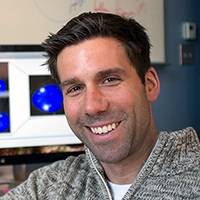 Harvard Stem Cell Institute is pleased to announce four of our Principal Faculty members have been named Howard Hughes Medical Institute (HHMI) Faculty Scholars. Fernando Camargo, Benjamin Ebert, Jayaraj Rajagopal, and John Rinn are among the 84 early-career scientists selected this year by HHMI for their potential to make unique contributions to their field. Their HHMI projects are as follows:
Harvard Stem Cell Institute is pleased to announce four of our Principal Faculty members have been named Howard Hughes Medical Institute (HHMI) Faculty Scholars. Fernando Camargo, Benjamin Ebert, Jayaraj Rajagopal, and John Rinn are among the 84 early-career scientists selected this year by HHMI for their potential to make unique contributions to their field. Their HHMI projects are as follows:
 Fernando Camargo, PhD, ofBoston Children’s Hospital, studies how single cells in the embryo develop into the many cells and complex tissue types that in the adult, using the blood system as a model. He will develop new tools and technologies to track cells at a very high resolution, which will allow him to map the lineage of every single cell tracing back from the adult cell to its ‘ancestral’ cell, or cell of origin, in the embryo.
Fernando Camargo, PhD, ofBoston Children’s Hospital, studies how single cells in the embryo develop into the many cells and complex tissue types that in the adult, using the blood system as a model. He will develop new tools and technologies to track cells at a very high resolution, which will allow him to map the lineage of every single cell tracing back from the adult cell to its ‘ancestral’ cell, or cell of origin, in the embryo.
“It’s always a great honor to be recognized with this award, and I think it reflects on the hard work and the quality of people in my lab,” said Camargo.
 Benjamin Ebert, MD, PhD, of Brigham and Women’s Hospital, focuses on the genetics, biology, and therapy of blood cancers. Scientists have identified a set of genes that are recurrently mutated in a condition called bone marrow failure disorder and other blood cancers. Ebert will study the biology of key genetic lesions, the clinical impact of these mutations, and potential therapeutic targets.
Benjamin Ebert, MD, PhD, of Brigham and Women’s Hospital, focuses on the genetics, biology, and therapy of blood cancers. Scientists have identified a set of genes that are recurrently mutated in a condition called bone marrow failure disorder and other blood cancers. Ebert will study the biology of key genetic lesions, the clinical impact of these mutations, and potential therapeutic targets.
"I feel very honored to receive this support and excited by the flexibility this funding will provide to investigate more exploratory lines of investigation."
 Jayaraj Rajagopal, MD, of Massachusetts General Hospital examines how multiple, single cells interact as an ensemble and function as a single tissue, using lung tissue as a model. Currently, scientists grow organoids to visualize how cells communicate as they develop, but Rajagopal will develop explant methods to create models that more closely reflect physiology inside the body. Using modern genetics and imaging techniques to understand how single cells interact with their neighbors will allow Rajagopal to better describe physiology, including the physiology of diseased tissue.
Jayaraj Rajagopal, MD, of Massachusetts General Hospital examines how multiple, single cells interact as an ensemble and function as a single tissue, using lung tissue as a model. Currently, scientists grow organoids to visualize how cells communicate as they develop, but Rajagopal will develop explant methods to create models that more closely reflect physiology inside the body. Using modern genetics and imaging techniques to understand how single cells interact with their neighbors will allow Rajagopal to better describe physiology, including the physiology of diseased tissue.
“This is a fantastic opportunity to meet an exceptional group of scientists who I know will improve the quality of my own work. And the grant allows me the freedom to really start new avenues of research for the questions I’m most interested in,” said Rajagopal.
 John Rinn, PhD, of Harvard University’s Stem Cell and Regenerative Biology department, studies the products of what researchers used to call “junk DNA,” — the 98% of the genome that does not code for a protein, but may, as researchers are now discovering, perform other functions in the body. With the HHMI Faculty Scholar grant, Rinn will look at Firre, a long non-coding RNA (lncRNA) associated with human disease, and build a molecular vocabulary that he hopes will help researchers translate the actions of other lncRNAs.
John Rinn, PhD, of Harvard University’s Stem Cell and Regenerative Biology department, studies the products of what researchers used to call “junk DNA,” — the 98% of the genome that does not code for a protein, but may, as researchers are now discovering, perform other functions in the body. With the HHMI Faculty Scholar grant, Rinn will look at Firre, a long non-coding RNA (lncRNA) associated with human disease, and build a molecular vocabulary that he hopes will help researchers translate the actions of other lncRNAs.
“We need to know the basic words and how they’re put together to understand how these molecules function,” said Rinn. “It’s an honor that HHMI supports this high-risk, high-reward type of work. “
